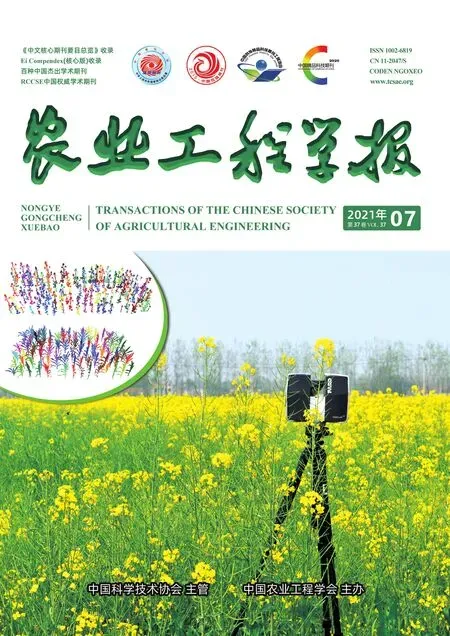作物叶片表面农药残留的便携式检测仪器的设计与试验
孙 俊,唐宝文,周 鑫,姚坤杉,胡双齐,张 林
作物叶片表面农药残留的便携式检测仪器的设计与试验
孙 俊,唐宝文,周 鑫,姚坤杉,胡双齐,张 林
(江苏大学电气信息工程学院,镇江212013)
针对现有的农药残留检测仪器只能检测水溶液体系中的农药残留和检测对象较为单一的问题,该研究以不同植物叶片啶虫脒农药残留为研究对象,探究了利用荧光强度检测叶片表面农药残留的可行性,设计了一款叶片表面农药残留的便携式检测仪器。首先,通过啶虫脒农药叶片表面喷洒试验,采集叶片的荧光光谱并进行特征分析,发现啶虫脒农药的最佳激发波长和最佳发射波长分别为355 和500 nm,从而确定光源和光电信号接收源的特征波长分别为350和500 nm。然后,通过获取最佳光源照射角度以及光照距离,优化光路结构减少叶片表面杂散光的干扰。同时,设计相关检测电路(光源电路、信号调理电路、控制电路等)测出表征反射光强度的电压值,构建电压值与农药残留值之间的线性方程,设计便携式检测仪对农药残留进行检测。结果表明:1)荧光强度与农药浓度在1~5 mg/L的范围内成正比;2)确定了检测仪器最佳光照角度为45o,光源和待测叶片之间的最佳垂直距离为3.46 cm;3)方程决定系数达到了0.875,均方根误差为0.405 mg/L。该研究所设计的便携式荧光光谱仪能够快速、准确、无损检测叶片表面农药残留。
农作物;农药;叶片;荧光光谱;光学系统;检测仪器
0 引 言
农业生产中,农药对病虫害的防治发挥着非常重要的作用,然而附着在农产品上残留的农药威胁着人们的身体健康[1],因此,实现对农药残留的精准检测对保证食品安全和保护人体健康具有重大意义。
目前,农药残留的检测技术主要包括气相色谱法[2]、液相色谱法[3]、气质联用法[4]等,这些方法虽然检测灵敏度高、专属性强、准确性好,但样品前期预处理过程繁琐、仪器设备昂贵、仪器体积较大、数据处理繁琐、便携性较差,不能满足农药残留检测实时与快捷的要求[5]。近年来,荧光光谱法在农药残留检测领域取得了相当大的发展[6],荧光光谱法检测精度高、仪器结构简单、成本低。为了满足农药残留的快速实时检测的需求,多位学者设计了基于激发荧光的便携式检测仪器。王玉田等设计了一个荧光光纤农药残留系统,实现了水溶液和蔬菜汁中克百威、西维因等农药的直接检测,最低检出限低于5g/L[7]。郭立泉等采用365 nm波长的LED作为激发光源辅以中心波长为450 nm的光电二极管接收荧光信号,成功实现了对荧光物质4-甲基伞形酮的检测,所设计的系统检测误差小于1.5%[8]。但这些检测仪器主要是检测水溶液体系中的农药残留,直接检测植物叶片表面农药残留的便携式检测仪器较少,不能满足农业生产生活中初检与速检的要求。
利用荧光光谱法直接检测叶片表面农药残留容易受到光源照射角度[9-10]、叶片表面平滑度[11]、叶片放置位置[12]等内在与外在因素的影响,从而导致检测结果的不确定性,难以满足精准农业对农药残留检测的要求,且对便携式检测仪器的设计方面研究较少[13]。因此,本研究拟以叶片表面农药残留检测为目标,通过叶片表面农药喷洒试验,获取荧光的最佳发射与最佳激发波长,探究利用荧光强度检测叶片表面农药残留的可行性,分析影响叶片表面农药残留检测精度的相关因素,优化光路结构,设计相应检测电路,以期设计开发一款叶片表面农药残留检测仪器。
1 数据采集与波长选择
1.1 试验材料
啶虫脒(70%啶虫脒散颗粒剂)用水溶液以及甲醇(分析纯AR,99.5%)按照1:4的质量比稀释成4个不同梯度(1:200、1:300、1:500、1:1 000)的配比农药溶液,将配置好的啶虫脒溶液放置在容器中备用。
选取大小相近,表面无损伤的生菜、菠菜、大白菜叶片样品各60株。试验前,用干净的半湿毛巾擦拭样品表面,并按顺序贴上标签,在植物叶片表面喷洒啶虫脒溶液。用移液枪分别移取不同浓度的啶虫脒标准溶液1 mL,依次喷洒在样品表面,并自然干燥10 min,使植物叶片表面形成啶虫脒标准溶液的薄膜,随后进行植物叶片样样品荧光数据的采集。
1.2 荧光光谱采集装置
荧光光谱数据采集仪器为FHSI系统,包括一台带有光谱成像系统软件的计算机、光谱仪(V10E,SPECIM,芬兰)、照相机(Zyla4.2,安道尔,UTKL)、UVA光源(UBerLED100,IT,美国)、电控位移台(MSI300,五十铃光学,台湾)。光谱范围为400~1 000 nm,光谱分辨率为2.8 nm。仪器参数设置如下:图像分辨率设置为2 048×478(即空间像素点为2 048,波段数为478),相机焦距为23 mm,样品到镜头距离为0.45 m,相机曝光时间为0.1 s,电控位移台速度为1.255 2 mm/s。
1.3 农药残留含量检测
将测定完毕的每组叶片样品置于50 mL的烧杯中,加入10 mL的HCl浸泡,烧杯封口后用超声震荡,萃取液转移至100 mL的烧杯中使用乙腈溶液定容,测量其荧光强度。再配置一系列啶虫脒标准溶液,建立一定浓度范围的啶虫脒标准溶液的标准工作曲线,将上述测得的萃取液的荧光强度与所建工作曲线进行对比,从而确定萃取液中啶虫脒的含量,进而换算成生菜叶片表面啶虫脒的含量。
1.4 特征波长选择
由于植物叶片表面具有一定的生物活性,且表面的结构与活性均不同,让残留在植物叶片表面的啶虫脒农药产生了一定的程度的代谢,可能会对表面的啶虫脒的荧光信号产生一定的影响[14]。因此,考察啶虫脒标准溶液在不同植物表面上的荧光信号,以确定啶虫脒标准溶液在植物叶片表面的最佳激发波长与最佳发射波长。当植物受外界环境光照射时,其内部叶绿素会被激发产生荧光,这将影响啶虫脒受光照激发出的荧光,本文先对植物本身叶片产生的荧光光谱进行分析。利用荧光光谱系统对生菜、菠菜、白菜叶片样品在400~1 000 nm范围内采集荧光光谱。图1是洁净植物叶片的荧光光谱,包括生菜、白菜、菠菜等植物叶片。从图1中可以看出生菜、白菜、菠菜叶片的荧光光谱差异极小,波峰位于690和735 nm处。
图2为喷洒不同浓度啶虫脒溶液的生菜、菠菜、白菜样本的荧光光谱,其中500 nm附近处为啶虫脒农药的荧光发射波长[15],而690和735 nm则是叶片中叶绿素的荧光发射波长[16]。因此,本文选用500 nm作为植物叶片表面啶虫脒溶液的特征峰。啶虫脒受到355 nm的紫外荧光激发时,啶虫脒溶液荧光发射波峰位于500 nm附近,其荧光强度与农药浓度在1~5 mg/L范围内成正比,啶虫脒标准溶液的最佳激发波长为350 nm,最佳发射波长为500 nm,该结果与文献[17-18]研究结果一致。
2 仪器设计
2.1 系统框架
农药残留检测仪器主要由检测电路模块和光路模块两个模块组成,总体结构图如图3所示。
a. 原理图
a. Law diagram
1、2.光源激发模块 3.透镜 4.固定圈 5.反射杯 6.光电二极管 7.待检测叶片放置台
1,2. Light source excitation module 3Lens 4.Fixing ring 5.Reflector cup 6.Photodiode 7.Placement table for the leaf to be inspected
b. 结构示意图
b. Structure diagram
图3 仪器结构图
Fig.3 Schematic diagram of the instrument structure
光路模块主要采用的反射式光路结构,激发光源与光电二极管位于叶片表面的同一侧。光源激发模块由中心波长为350 nm的照射镜头组成,每个照射镜头由窄带滤光片和LED组成,模块结构简单,有利于后续仪器模块化组装。干涉滤光片选取窄带滤光片,该滤波片的中心波长为350 nm,透过率大于80%,截止深度为OD4,能够有效降低其他波长的干扰光通过。
啶虫脒农药的吸收光波带较窄,因此使用窄带滤光片,有效的减少二级光谱的干扰。光电二极管前端的干涉滤光片选用诱导透射膜系带通滤光片,其中心波长为500 nm,透过率为70%,带宽为20 nm,截止深度为OD4。光电二极管选用的S9219-01型光电二极管,其光谱响应范围为380~780 nm,灵敏度峰值响应范围较宽,约480~550 nm,感光灵敏度为0.24 A/W,暗电流为10 pA。
2.2 光路设计
检测植物叶片表面农药残留时,检测结果易受到叶片表面平滑度与自身生物活性的干扰[19]。经典漫反射与镜面反射光路结构都不能有效的消除叶片表面农药残留检测时干扰信号的影响,因此需要设定植物叶片表面农药残留检测系统的条件参数(最佳激发波长与最佳发射波长、光源照射角度、光源照射距离等)。
2.2.1 光源照射角度的优化
光源照射角度、位置不同,干扰信号的位置与强度也会有所不同,因此需要选择最佳的光源照射角度[20]。图4为啶虫脒标准溶液同样浓度下3个光照角度下生菜叶片样本的荧光光谱图,在不同的光照角度下,啶虫脒标准溶液的最佳发射峰均为500 nm,但荧光的强度有着明显的差异。当光照角度为45°时,荧光强度最大,光照角度设置为60°时,荧光强度次之,当光照角度设置为30°时,荧光强度最低。
由图4可知,入射光角度对植物叶片表面啶虫脒农药激发出的荧光信号的强度存在着很大的影响,当光源照射角度为45°时,生菜叶片表面啶虫脒农药激发出的荧光信号强度最强。
2.2.2 光源照射距离的优化
检测植物叶片表面的农药残留是根据荧光信号的强度来定量的[21],须保证每次所检测到的荧光信号所对应的农药物质的量是一致的,需要保证叶片的大小与LED的光斑大小一致,让整个待检测叶片全部被光斑覆盖。但是随着LED与待检测叶片之间距离的变大,LED光斑面积会增大,较大的光斑面积会影响光照强度,进而影响农药发射荧光的强度[22]。为了提高检测系统的精度,需要综合考虑LED灯光斑面积与LED灯光照强度两个特性参数,对检测系统的光源照射距离进行优化[23]。
根据照度的余弦法则,由LED激发出的光在待检测叶片上的照度为
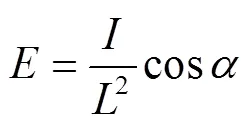
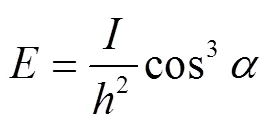
式中为LED的发光强度,cd;为光源照度,lx;为待检测叶片距离光源的直线距离,cm;为光源距离待检测叶片的垂直距离,cm。为光源与待检测叶片之间的夹角,(°)。
可见随着LED激发光源到待检测叶片之间距离的增加,照射到叶片表面上的光照度会急剧减小。此外,LED的照射光在空气中传播,经传播距离后光斑面积[24]为

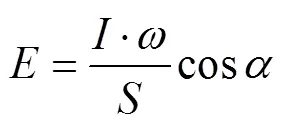
式中为视场角,rad;为光斑面积,cm2;
由式(4)可知照射到叶片表面上的光照度与光斑面积成反比。由于设置待检测叶片面积为4 cm2,因此设置光斑面积为4π cm2,略大于叶片面积。设计传感器的视场角为30°,则

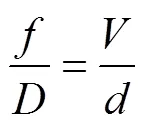
通过计算可知,光电二极管与透镜之间的距离为1.1 cm,此时光电二极管可有效接收到待检测叶片的反射光。
2.3 电路设计
测量光谱信号时,光电二极管接收到的荧光信号为微安级别的微弱信号,光电二极管在接收荧光信号并进行光电转换的过程中,不仅会输出检测电压信号或者检测电流信号,还会输出无用的噪声电压或者噪声电流[26]。针对这个问题,本文设计的电路主要包括电流电压转换电路、二级放大电路、带通滤波电路等,能够满足将微弱信号放大并减小噪声的干扰的要求[27]。
运算放大器OPA380具有高精度、高稳定性和低噪声的优点,故选择由运算放大器OPA380设计电流放大型检测电路,其输出电压与输入短路光电流成正比,,输出电压信号与输入短路光电流成正比。此时的输出电压为毫伏级,为了满足模数转换的要求,需要将毫伏级的电压信号进行放大。因此,采用INA128芯片设计了一个增益可调的低燥放大电路,具体的增益倍数为:=1+50/1。其中,1为外接电阻的阻值,设置为2 kΩ,电路的实际增益是26,可以将输出电压放大至伏级,满足A/D转换芯片的采样要求。然后通过带通滤波电路进行信号选择,对不需要的频率信号进行抑制,可以有效的降低电路中的白噪声。对于低通滤波电路,电容一般选取1 000 pF,对于高通滤波器,电容一般选取0.1F,此外光源驱动电路采用的是1 kHz的PWM波调制,随后根据截至频率公式,计算出R3和R4的阻值分别为20 和1 kΩ。OUT为电路的输出端,检测电路如图6所示。
运算放大器OPA380采用零偏置,光电二极管会产生一个很小的正向或者反向偏置电压[28],经过电路的放大偏置电压会对检测电路的精度产生很大的影响。因此在本文检测电路中,运算放大器的两端还需要与一个基准电压源VREF相连接,基准电压源具有自身稳定的特性,波动较小,可以有效的起到抗干扰的作用[29]。
3 仪器性能测试与标定
3.1 试验数据获取
选择新鲜生菜叶片样品60片,避免茎干部分,裁剪叶片成表面大小为4 cm2的叶片块。在叶片块上分别用移液枪移取不同浓度的啶虫脒溶液1 mL。待自然风干10 min之后,利用自制仪器测量不同浓度下的农药残留值,为了减小测量误差,测量3次取平均值。
随后使用荧光光谱数据采集仪器采集叶片表面的荧光光谱,确定啶虫脒标准溶液对应的最佳激发波长处的荧光光强。将测定完毕的每组叶片,将样品置于50 mL的烧杯中,加入10 mL HCl浸泡,烧杯封口用超声震荡,萃取液转移至100 mL的烧杯中使用乙腈溶液定容,测量其荧光强度。建立0~5 mg/L范围内的啶虫脒标准溶液的标准工作曲线,将上述测得的萃取液的荧光强度与所建啶虫脒标准溶液工作曲线进行对比,从而定量萃取液中啶虫脒的量,进而换算成叶片表面啶虫脒的量。
3.2 试验验证
3.2.1 重复性验证
仪器重复性是衡量仪器性能的一个重要指标[30]。本文对生菜叶片进行反射电压测量,测量结果如图7所示。
由测试结果可知,检测仪器在4个浓度下的输出电压基本保持不变,最大的标准偏差仅为4%,表明检测仪器重复性良好,输出结果稳定。
3.2.2 精度验证
啶虫脒农药残留检测中,LED光源发出检测荧光信号,光电二极管接收照射到待检测叶片表面所反射回来的荧光信号,经检测电路处理,将模拟量的荧光信号转换为能被检测到数字量电压信号,该电压信号标记为反射电压。可以根据检测数据建立相对荧光强度(通过检测电路将荧光强度换算成的电压值)与农药浓度的模型,测定得到的啶虫脒农药相对荧光强度如表1所示。
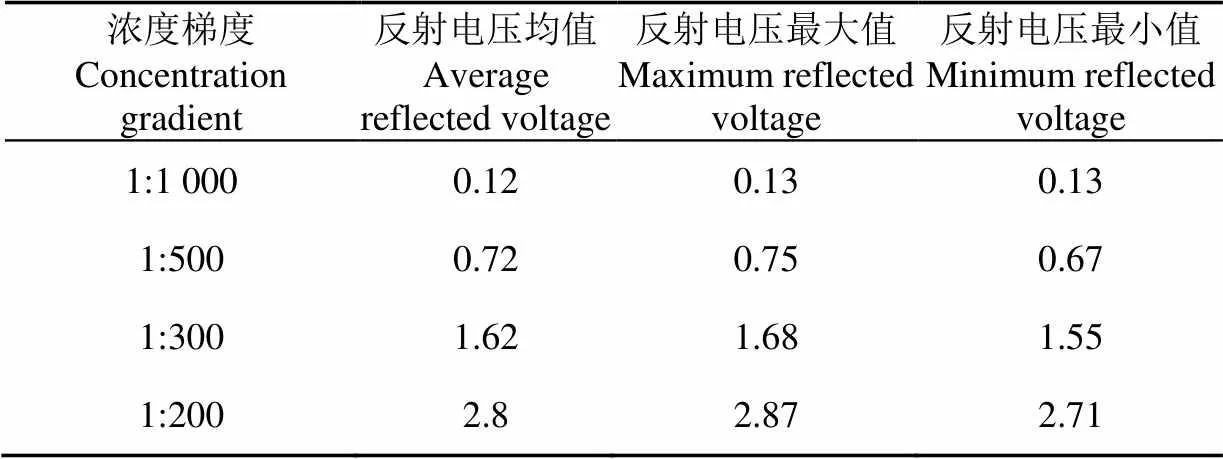
表1 啶虫脒农药浓度标准曲线的相对荧光强度表
注:相对荧光强度用换算的电压值表示。
Note: Reflected voltage is converted into relative fluorescence intensity.
对测量数据进行拟合,相对荧光强度(通过检测电路将荧光强度换算成的电压值)与农药残留量拟合的线性方程为=1.481+0.876 3,式中为农药残留值,为反射电压值。农药残留的预测值和实测值的相关图如图8所示,方程决定系数2为0.875,均方根误差RMSE为0.405 mg/L。
4 结 论
本文以啶虫脒农药残留的植物叶片为研究对象,将荧光光谱技术应用到叶片表面农药含量的无损检测中,采集了啶虫脒溶液在叶片表面的荧光光谱,确定啶虫脒溶液的最佳激发波长和最佳发射波长分别为355和500 nm,确定光源与光电信号接收器的特征波长分别为350和500 nm。在此基础上,根据荧光检测原理选择了相应的光学器件,优化了光路结构的条件参数,确定检测仪器的最佳光照角度为45°,设定光源与待检测叶片之间的最佳垂直距离为3.46 cm。同时,设计相关检测电路,用于获取表征反射光强度的电压值,构建标定方程,在此基础上建立了便携式检测仪器测量值关系模型,关系模型决定系数为0.875,均方根误差为0.405 mg/L。本研究所设计的便携式检测仪器对叶片表面农药残留有着良好的检测效果。
本文已经验证了叶片表面农药残留的可行性,为研制更具普适性的便携式农残检测仪器提供参考。本文试验设置的农药梯度范围仅包含典型农药梯度范围,但在实际农药喷洒过程中,残留在叶片表面上的农药含量可能因为喷洒过程中角度或者遮挡等因素而低于本文中设置的最低农药梯度,因此如何进一步提高农药的最低检测限,尚需要进一步地深入研究。
[1] 孙俊,张梅霞,毛罕平,等. 基于高光谱图像的桑叶农药残留种类鉴别研究[J]. 农业机械学报,2015,46(6):251-256.
Sun Jun, Zhang Meixia, Mao Hanping, et al. Identification of pesticide residues on mulberry leaves based on hyperspectral imaging[J]. Transactions of the Chinese Society for Agricultural Machinery, 2015, 46(6): 251-256. (in Chinese with English abstract)
[2] Chen H P, Wang X L, Liu P X, et al. Determination of three typical metabolites of pyrethroid pesticides in tea using a modified QuEChERS sample preparation by Ultra-High performance liquid chromatography tandem mass spectrometry[J]. Foods, 2021, 10(1): 189.
[3] Zhou Q X, Wu Y L, Sun Y, et al. Magnetic polyamidoamine dendrimers for magnetic separation and sensitive determination of organochlorine pesticides from water samples by high-performance liquid chromatography[J]. Journal of Environmental Sciences, 2021, 102(4): 64-73.
[4] Li S, Yu P P, Zhou C, et al. Analysis of pesticide residues in commercially available chenpi using a modified QuEChERS method and GC-MS/MS determination[J]. Journal of Pharmaceutical Analysis, 2020, 10(1): 60-69.
[5] 陈菁菁,彭彦昆,李永玉,等. 基于高光谱荧光技术的叶菜农药残留快速检测[J]. 农业工程学报,2010,26(14):1-5.
Chen Jingjing, Peng Yankun, Li Yongyu, et al. Rapid detection of vegetable pesticide residue based on hyperspectral fluorescence imaging technolog[J]. Transactions of the Chinese Society of Agricultural Engineering (Transactions of the CSAE), 2010, 26(14): 1-5. (in Chinese with English abstract)
[6] Lin G H, Ji R D, Yao H, et al. Fluorescence detection of multiple kinds of pesticides with multi hidden layers neural network algorithm[J]. Optik, 2020, 211: 164-170.
[7] 王玉田,王忠东,关晓晶. 一种检测西维因农药残留的光纤式荧光光谱系统的研究[J]. 分析测试技术与仪器,2004(4):210-213.
Wang Yutian, Wang Zhongdong, Guan Xiaojing. Research on a fiber-optic fluorescence spectroscopy system for detecting pesticide residues in carbaryl[J]. Analysis and Testing Technology and Instruments, 2004(4): 210-213. (in Chinese with English abstract)
[8] 郭立泉,尹焕才,田晶晶. LED激发光源的荧光物质快速检测系统设计[J]. 传感器与微系统,2017,36(5):106-108.
Guo Liquan, Yin Huancai, Tian Jingjing. Design of a rapid detection system for fluorescent substances based on LED excitation light source[J]. Sensors and Microsystems, 2017, 36(5): 106-108. (in Chinese with English abstract)
[9] 龚志远,李轶凡,刘燕德,等. 光源照射角度对苹果糖度近红外光谱检测的影响研究[J]. 激光与光电子学进展,2016,53(2):241-246.
Gong Zhiyuan, Li Yifan, Liu Yande, et al. Research on the influence of light source irradiation angle onnear-infrared spectroscopy detection of apple sugar content[J]. Progress in Laser and Optoelectronics, 2016, 53(2): 241-246. (in Chinese with English abstract)
[10] 孟夏,谢东辉,汪艳,等. 叶片多角度偏振光谱特性影响因素的实验研究[J]. 光谱学与光谱分析,2014,34(3):619-624.
Meng Xia, Xie Donghui, Wang Yan, et al. Experimental study on the influence factors of the multi-anglepolarization spectrum characteristics of leaves[J]. Spectroscopy and Spectral Analysis, 2014, 34(3): 619-624. (in Chinese with English abstract)
[11] 郑建鸿,吴瑞梅,熊俊飞,等. 基于光谱角算法的鲜茶叶表面农药残留荧光高光谱图像无损检测研究[J]. 激光杂志,2016,37(6):57-60.
Zheng Jianhong, Wu Ruimei, Xiong Junfei, et al. Research on non-destructive detection of pesticide residues on the surface of fresh tea using fluorescence hyperspectral images based on spectral angle algorithm[J]. Laser Journal, 2016, 37(6): 57-60. (in Chinese with English abstract)
[12] 杨杰,吴凡. 粗糙表面可见光散射特性的实验研究[J]. 中国测试,2009,35(2):125-128.
Yang Jie, Wu Fan. Experimental study on the visible light scattering characteristics of rough surfaces [J].China Test, 2009, 35(2): 125-128. (in Chinese with English abstract)
[13] 蔡世炎,游文玮,李耀群. 导数同步荧光法快速检测香菇中的多菌灵[J]. 分析测试学报,2007(1):117-119.
Cai Shiyan, You Wenwei, Li Yaoqun. Derivative synchronous fluorescence method for rapid detection of carbendazim in shiitake mushrooms[J]. Chinese Journal of Analysis Testing, 2007(1): 117-119. (in Chinese with English abstract)
[14] 许良,刘红婕,黄进,等. 激光诱导时间分辨固体表面荧光光谱系统[J]. 强激光与粒子束,2012,24(8):1961-1964.
Xu Liang, Liu Hongjie, Huang Jin, et al. Laser-induced time-resolved solid surface fluorescence spectroscopy system[J]. High Power Laser and Particle Beam, 2012, 24(8): 1961-1964. (in Chinese with English abstract)
[15] 季仁东,赵志敏,张林,等. 苹果汁中吡虫啉农药残留荧光检测研究[J]. 光谱学与光谱分析,2013,33(3):668-671.
Ji Rendong, Zhao Zhimin, Zhang Lin, et al. Fluorescence detection of imidacloprid pesticide residues in apple juice[J]. Spectroscopy and Spectral Analysis, 2013, 33(3): 668-671. (in Chinese with English abstract)
[16] 王琳琳,于海业,张蕾,等. 基于叶绿素荧光光谱的生菜硝酸盐含量检测[J]. 农业工程学报,2016,32(14):279-283.
Wang Linlin, Yu Haiye, Zhang Lei, et al. Detection of nitrate content in lettuce based on chlorophyll fluorescence spectrum[J]. Transactions of the Chinese Society of Agricultural Engineering (Transactions of the CSAE), 2016, 32(14): 279-283. (in Chinese with English abstract)
[17] 王忠东,王玉田. 常用农药荧光特性的理论与实验[J]. 发光学报,2005(1):124-128.
Wang Zhongdong, Wang Yutian. Theories and experiments on the fluorescence characteristics of commonly used pesticides[J]. Acta Luminescence, 2005(1): 124-128. (in Chinese with English abstract)
[18] 王泽. 植物农药残留的三维荧光光谱特征提取及识别方法研究[D]. 西安:西安理工大学,2018.
Wang Ze. Research on Feature Extraction and Recognition Method of Three-dimensional Fluorescence Spectra of Plant Pesticide Residues[D]. Xi'an: Xi'an University of Technology, 2018. (in Chinese with English abstract)
[19] 薛龙,黎静,刘木华,等. 荧光光谱检测脐橙表面敌敌畏残留试验研究[J]. 江西农业大学学报,2011,33(2):394-398.
Xue Long, Li Jing, Liu Muhua, et al. A Study on Detection of dichlorvosresidue on navel orange surface by means of fluorescence spectrum[J]. Acta Agriculturae Universitis Jiangxiensis, 2011, 33(2): 394-398. (in Chinese with English abstract)
[20] 倪军,王婷婷,姚霞,等. 作物生长信息获取多光谱传感器设计与试验[J]. 农业机械学报,2013,44(5):207-212.
Ni Jun, Wang Tingting, Yao Xia, et al. Design and experiments for multi-spectral sensor for rice and wheat growth information[J]. Transactions of the Chinese Society for Agricultural Machinery, 2013, 44(5): 207-212. (in Chinese with English abstract)
[21] 杜克钊,朱亚先,王萍,等. 固体表面荧光法测定吸附于白骨壤和木榄叶片上的蒽[J]. 分析试验室,2009,28(4):81-83.
Du Kezhao, Zhu Yaxian, Wang Ping, et al. Determination of anthracene adsorbed on avicennia marina and aralia vulgaris leaves by solid surface fluorescence method[J]. Laboratory of Analysis, 2009, 28(4): 81-83. (in Chinese with English abstract)
[22] Gong X Y, Tang M, Gong Z J, et al. Screening pesticide residues on fruit peels using portable Raman spectrometer combined with adhesive tape sampling[J]. Food Chemistry, 2019, 295(15): 254-258.
[23] 谢欣茹,杨波,潘帅,等. 多通道PCR荧光检测仪的光学系统设计[J]. 光学技术,2019,45(5):531-534,640.
Xie Xinru, Yang Bo, Pan Shuai, et al. Optical system design of multi-channel PCR fluorescence detector[J]. Optics Technology, 2019, 45(5): 531-534, 640. (in Chinese with English abstract)
[24] 郭培源. 光电检测技术与应用[M]. 北京:北京航空航天大学出版社,2015:114-115.
[25] 孔孟晋,徐君,阎巍,等. 微型近红外光谱仪低功耗系统的设计[J]. 分析仪器,2018(6):20-26.
Kong Mengjin, Xu Jun, Yan Wei, et al. Design of low power consumption system of miniature near infrared spectrometer[J]. Analytical Instruments, 2018(6): 20-26. (in Chinese with English abstract)
[26] 贺冬仙,胡娟秀. 基于叶片光谱透过特性的植物氮素测定[J]. 农业工程学报,2011,27(4):214-218.
He Dongxian, Hu Juanxiu. Determination of plant nitrogen based on leaf spectrum transmission characteristics[J]. Transactions of the Chinese Society of Agricultural Engineering (Transactions of the CSAE), 2011, 27(4): 214-218. (in Chinese with English abstract)
[27] 邹兵,侯加林,李民赞. 基于光谱学和ARM的番茄叶绿素检测仪的开发[J]. 农业工程学报,2010,26(增刊2):223-227.
Zou Bing, Hou Jialin, Li Minzan. Development of tomato chlorophyll detector based on spectroscopy and ARM[J]. Transactions of the Chinese Society of Agricultural Engineering (Transactions of the CSAE), 2010, 26(Supp.2): 223-227. (in Chinese with English abstract)
[28] 丁永前,李杨,谭星祥,等. 冠层反射光谱测量中主动光源光谱稳定性控制[J]. 农业机械学报,2014,45(6):284-290.
Ding Yongqian, Li Yang, Tan Xingxiang, et al. Active light source spectral stability control in canopy reflectance spectrum measurement[J]. Transactions of the Chinese Society of Agricultural Machinery, 2014, 45(6): 284-290. (in Chinese with English abstract)
[29] 刘乃森,倪军,董继飞,等. 多光谱作物生长传感器温度特性试验[J]. 农业工程学报,2014,30(21):157-164.
Liu Naisen, Ni Jun, Dong Jifei, et al. Temperature characteristic experiment of multispectral crop growth sensor[J]. Transactions of the Chinese Society of Agricultural Engineering (Transactions of the CSAE), 2014, 30(21): 157-164. (in Chinese with English abstract)
[30] 陈佳俊,孙俊,李亚婷,等. 反射式叶片叶绿素含量检测仪的优化与试验[J]. 农业工程,2020,10(6):28-35.
Chen Jiajun, Sun Jun, Li Yating, et al. Optimization and experiment of reflection type leaf chlorophyll content detector[J]. Agricultural Engineering, 2020, 10(6): 28-35. (in Chinese with English abstract)
Design and test of a portable detection instrument for pesticide residues on crop leaves
Sun Jun, Tang Baowen, Zhou Xin, Yao Kunshan, Hu Shuangqi, Zhang Lin
(212013,)
Fluorescence has unique luminescence characteristics. The combination of excitation light and emission light can greatly reduce the interference of background signals and greatly improve the sensitivity of the detection system. Many scholars at home and abroad obtain the optimal excitation and emission wavelengths of the analyte based on the principle of photoluminescence of fluorescent substances, and have developed miniaturized, low-cost dedicated instruments. However, the current portable instruments which focus on detecting pesticide residues in the solution system cannot realize directly detection pesticide residues on the surface of vegetable leaves. In this study, a feasible model for pesticide residues and fluorescence intensity on the leaf surface was proposed, and a portable detection instrument for pesticide residues on the leaf surface was designed by optimizing the light path structure to suppress the interference of stray light on the leaf surface. Firstly, the best excitation wavelength and best emission wavelength of acetamiprid pesticide in standard solution and three plant leaves were determined as 350 and 500 nm, respectively. An LED with a central wavelength of 350 nm and a maximum drive current of 100 mA was selected as the excitation light source, and a photodiode with a peak response range from 480 to 580 nm was used as the photoelectric detection device. A filter with a center wavelength of 500 nm was used to only let through the emission wavelength of the acetamiprid pesticide pass to reduce the interference of the secondary spectrum. Then the optimal parameters of the optical path are determined. The fluorescence experiments results showed that the fluorescence intensity excited by acetamiprid pesticide on the leaf surface was the highest when the light Angle was 45°. By calculating the optical path size, it was found that the illumination of the blade was the largest when the direct distance from the LED laser source to the blade was 4.89 cm and the vertical distance was 3.46 cm. In addition, in view of the diffuse reflection problem of the light source illuminating the surface of the blade, a diffuse reflection device was designed to achieve the maximum absorption of light energy. The control circuit, driving circuit and detection circuit were designed according to the requirement of weak fluorescence signal detection. A signal detection system was designed with STM32 chip as the main control chip to collect the voltage signal of the detection circuit, and the pesticide residue value was calculated according to the working curve of pesticide residue value. The PWM wave was output to modulate the LED light source and the difference between the frequency of detecting light and the frequency of ambient light can suppress the interference of ambient light to the light source. Then, SPI and I2C communication protocols were used to communicate with AD acquisition chip and OLED display screen to realize real-time detection of pesticide residues and real-time display of pesticide residues. Finally, the calibration equation was established and a portable detector was designed to detect pesticide residues. The measuring instrument was calibrated and tested.The determination coefficient of the calibration equation reached 0.875, and the root mean square error is 0.405 mg/L. The portable fluorescence spectrometer designed in this study can quickly, accurately and non-destructively detect pesticide residues on the surface of leaves, which provided a reference for the development of a more universal portable detection instrument.
crops;pesticides; leaves; fluorescence spectroscopy; optical system; detection equipment
2021-02-10
2021-03-25
江苏高校优势学科建设工程(三期)资助项目(PAPD-2018-87);常州市社会发展科技支撑项目(CE20205031);江苏大学农业装备学部项目(4121680001);江苏省研究生科研与实践创新计划(SJCX19_0557)
孙俊,教授,博士,博士生导师。研究方向为计算机技术在农业工程中的应用。Email:sun2000jun@ujs.edu.cn
10.11975/j.issn.1002-6819.2021.07.008
S237
A
1002-6819(2021)-07-0061-07
孙俊,唐宝文,周鑫,等. 作物叶片表面农药残留的便携式检测仪器的设计与试验[J]. 农业工程学报,2021,37(7):61-67. doi:10.11975/j.issn.1002-6819.2021.07.008 http://www.tcsae.org
Sun Jun, Tang Baowen, Zhou Xin, et al. Design and test of a portable detection instrument for pesticide residues on crop leaves[J]. Transactions of the Chinese Society of Agricultural Engineering (Transactions of the CSAE), 2021, 37(7): 61-67. (in Chinese with English abstract) doi:10.11975/j.issn.1002-6819.2021.07.008 http://www.tcsae.org

